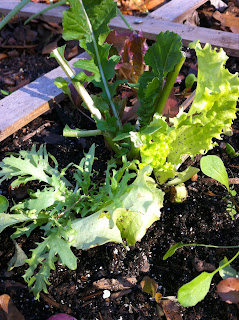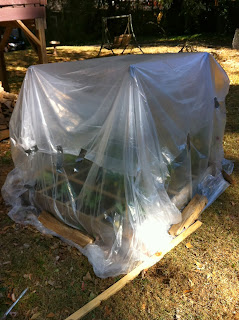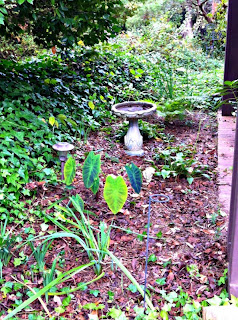I should be thinking about Christmas cards and Christmas presents, but all I really want to do this week is spend time in my garden. I decided earlier this fall that I wanted to try a cool-weather vegetable garden this year. I stocked up on seeds, read all I could, and got to work in September. August just seemed too hot to be planting cold-weather vegetables.
In September I planted salad greens, broccoli, and carrots from seed, and cauliflower from seedlings I bought at the hardware store. In October I planted radishes and spinach from seed, and red onions from sets (little baby onion bulbs).
Some of the salad greens in the first planting got washed away and/or dug up by the squirrels, so I planted more seeds a few weeks later. The first planting has produced some tasty, tender baby greens, but the second planting still just looks like little tiny seedlings. It turns out early September was the perfect time to be planting lettuce.
 |
| Mixed salad greens in my garden |
The broccoli seeds I planted in the garden didn't sprout at all. I read that broccoli grows much better when it's started as seedlings and then moved into the garden, so I made a later, half-hearted attempt to grow broccoli seedlings inside in vermiculite. They sprouted, but after a month of sitting on my windowsill, they still weren't very big. I got impatient and tried moving them into the garden, but they were fragile and snapped. Next year I'll try planting broccoli seeds inside in late summer, when the house is warmer, and use a different medium, and maybe I'll have some transplants ready to go in the garden by September.
The first planting of carrots died from lack of water when I was sick one warm, dry week in fall. I planted more in October, and they've stayed about an inch tall for the last month.
The cauliflower has been an epic failure, but I've learned a lot. First I fought off the cabbage worms, then I thought I had deer eating my plants. It turns out it wasn't deer--my last remaining cauliflower plant got eaten in spite of having a cage over it. Based on my research, it's probably cute little bunny rabbits that slipped in through the 4-inch gap under my cage, but I have yet to actually see rabbits in my yard. So it's still sort of a mystery. But next year I'll build a better cage.
The radishes look healthy, but also haven't gotten very big in this cold weather. I should have planted in September. They're surviving the cold, but if I get any radishes to eat, it won't be until February at this rate.
 |
| Spinach seedlings in my garden |
I accidentally planted onions on top of my spinach seeds because I forgot where I planted them. I planted some more spinach seeds in early November, and they continue to grow slowly but surely, despite the squirrels digging them up every other day with their incessant digging for acorns. I think if I had planted in late September, I would have had a nice crop by now. As it is, I might get some spinach in February.
The red onions look beautiful. They're sturdy enough that the squirrels don't bother them. I actually did a second planting in early November, and they're smaller, but just as happy as the October planting. It takes about 14 weeks on average for onion sets to mature, and it will probably take a little longer as a winter crop. I expect to enjoy nice, fat onions in late winter to early spring.
 |
| My red onions don't mind a little cold. |
Despite the setbacks, so far my cold-weather garden has been totally worth it. I won't get a huge harvest this year, but I know exactly what I need to do differently next year: plant earlier, water (almost) daily when the weather's warm, keep the insecticidal soap on hand, and build some really sturdy cages to keep out the cute, fluffy rodents. See? It's simple. :)













































